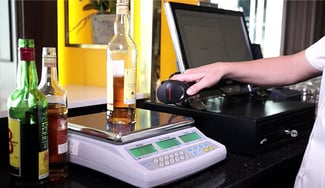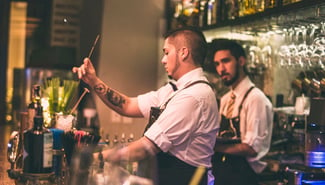If you’re considering upgrading your liquor inventory system, it’s important to do your research. Not all inventory systems are created equal. Some only provide basic functions, such as:
- Fast and efficient counting process
- Automate your ordering
- Calculate your liquor cost by category (draft beer, bottled beer, liquor and wine)
While these are important benefits that offer a significant improvement over counting inventory manually with a clipboard, these systems are still not providing you with the best possible value for your inventory efforts. By using an advanced liquor inventory system, you can take the process a step further and gather the data necessary to improve your profitability. We call this process level 3 inventory.
Your Goals for Your Bar Inventory Efforts Will Determine Which Systems to Evaluate
 Before you start evaluating new bar inventory systems, you must first establish the goals you’d like to achieve from the process:
Before you start evaluating new bar inventory systems, you must first establish the goals you’d like to achieve from the process:
- If you’re primarily concerned with saving time and calculating your liquor cost, you should evaluate options that provide level 2 inventory results.
- If you want to use your inventory efforts to identify specific products that are missing, reduce your liquor cost and improve your bar’s profitability, you’ll need to evaluate options that provide level 3 inventory results.
Level 3 inventory will provide you with the most robust data, allowing you to make changes to your operations that will drive profits. This is by far the most effective use of your efforts.
In our last blog post, we discussed the important elements to consider when evaluating basic systems providing level 2 inventory. Below, we’re going to review the elements you’ll need to consider if you want to upgrade to an advanced liquor inventory system that delivers the full range of benefits associated with level 3 inventory.
What Are the Most Important Elements Necessary for Level 3 Inventory?
Once you’ve done all the work to track level 2 inventory data, you’re most of the way towards collecting the information necessary for level 3 inventory. However, gathering level 3 inventory data will require a system that provides greater precision and detail.
Extremely Precise Counting Process
When you calculate liquor cost by category, you’re blending many different results into one aggregate figure. In this situation, it won’t matter if the amount of liquor in each bottle isn’t estimated accurately. However, when you’re trying to identify how many servings of a specific product are missing, you need significantly more precise counting data.
If you don’t accurately count all inventory down to the serving, it will cause you to experience incorrect results that will skew your understanding of how each product is actually performing. We recommend using a system that can measure inventory more accurately than a 1.5 oz. serving.
 To achieve this goal, Bar-i uses scales and zone counts:
To achieve this goal, Bar-i uses scales and zone counts:
- Our scales are accurate to the hundredth of an ounce and they allow you to count each bottle in under 2 seconds, providing extremely fast and accurate results.
- Our zone counting system helps you easily catch any counting errors. After you count each zone, you check the total number of items for every product in the zone to make sure the count was accurate.
Line by Line Deliveries
To achieve level 3 inventory, you need to know how many ounces of each product were delivered. Software can do this math for you by converting bottles into ounces. This is important data to know if you’re going to track how many ounces of each product were poured during the inventory period.
There is a lot of data entry involved in entering your deliveries line by line into your inventory system. A system that can enter deliveries for you, provides assistance with the process or automates the process will be very helpful in minimizing the amount of time your staff spends on this tedious task.
Bar-i enters the invoices for you. We also have the capability to extract this information using Optical Character Recognition (OCR) technology. This frees up your managers to devote additional time to other aspects of running the bar.
Button Level Sales
Level 3 inventory requires you to look at the sales per product. To do this, you need to create a recipe for every drink button on your POS system. This way, your inventory system will be able to identify precisely how many ounces of each product were sold during the period.
Creating these recipes can be a time-consuming task. They need to assign the specific amounts of every product used in the drink. When you serve craft cocktails, this can involve three or more different products. You need to think about who is going to write these recipes and how you’re going to manage them to ensure accuracy.
When Bar-i sets up a new client for level 3 inventory, the recipe writing process often takes two full days. We work with you to determine the proper recipes for each drink, and we enter this information into the system for you.
Comps, Voids and Adjustments
 A certain amount of adjustments are inevitable when you’re tracking data at this level of detail. For example, if you poured Jim Beam all night because you ran out of your well bourbon, you need a method of entering these types of adjustments into the system. This involves:
A certain amount of adjustments are inevitable when you’re tracking data at this level of detail. For example, if you poured Jim Beam all night because you ran out of your well bourbon, you need a method of entering these types of adjustments into the system. This involves:
- Staff communication
- Having a dedicated person responsible for entering these adjustments into the system
- Ensuring all adjustments are made in a timely manner so that you receive accurate inventory results
This can be complicated, and you’ll want to use a system that makes the process of entering these adjustments as easy as possible.
Error Resolution
You’re capturing a lot of data during the inventory process. Often 200+ items must be counted, and each item is stored in 2-3 separate locations throughout the bar. You also need to account for multiple deliveries during the inventory period. Therefore, it’s common for 10-20 data points to be involved in determining how many ounces of a specific product are missing during the period.
If you carry about 200 items, this means you may have 4,000 separate data points being captured during one inventory count. With such a large amount of data being collected, errors are inevitable. You need to have a system for identifying and resolving these errors.
Bar-i makes this process easy. We identify the errors and provide you with a variance report that shows you which items need to be checked. This is an important element to the process that many self-service inventory systems are lacking.
Recommendations and Follow-Up
 A lot of work is involved in producing these inventory results. The reason you’re doing all of this is to improve the performance of your bar. Therefore, you want to think about how you’re going to use the results to achieve your desired improvements:
A lot of work is involved in producing these inventory results. The reason you’re doing all of this is to improve the performance of your bar. Therefore, you want to think about how you’re going to use the results to achieve your desired improvements:
- If you’re using a self-service inventory system, you will need to analyze all the data yourself in order to determine the actions that need to be taken to improve your bar’s performance.
- If you’re using a managed inventory system like Bar-i, then you’ll have a dedicated inventory expert who possesses the additional context of how other similar bars are performing to analyze your data for you. You will then receive specific comments and recommendations related to how you can take steps to improve the performance of your bar.
This level of follow-up and recommendations is the way we make these inventory efforts worthwhile. We turn the results into recommendations for changes that will help improve your bar’s performance moving forward.
If you’d like to learn more about how Bar-i can streamline your operations and help you maximize profits, please contact us today to schedule a free consultation. We serve bars and restaurants nationwide from our offices in Denver, Colorado.


-1.png)